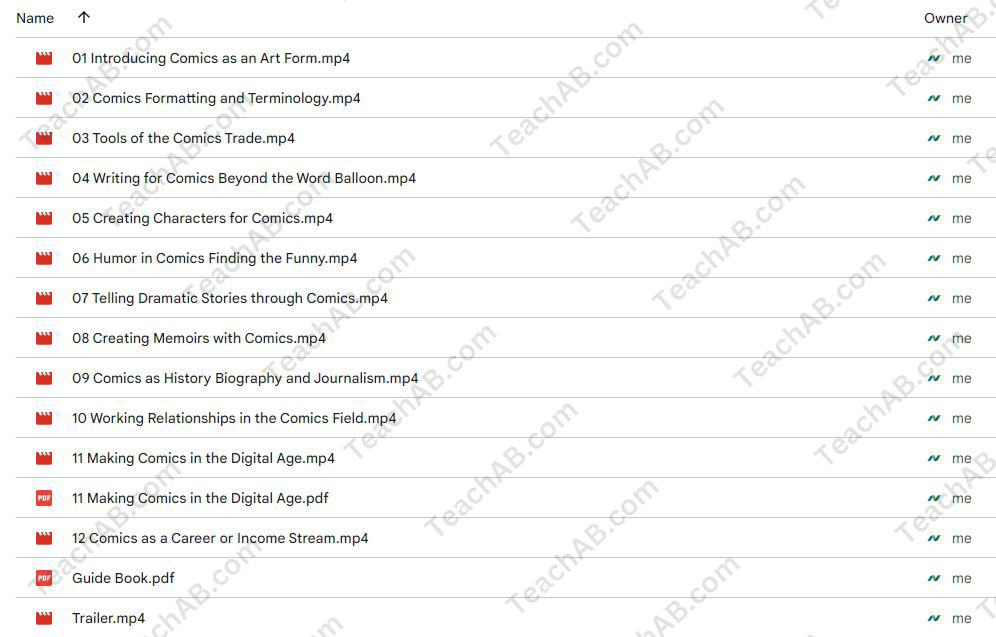How to Create Comics By Peter Bagge
$169.00 Original price was: $169.00.$5.00Current price is: $5.00.
Review of How to Create Comics by Peter Bagge
Content Proof:
In a world where storytelling breathes life into art, Peter Bagge’s course, “How to Create Comics,” emerges as a beacon for aspiring cartoonists and seasoned artists alike. Spanning twelve meticulously crafted lectures, this course provides an in-depth exploration of comic creation, marrying the technical intricacies with the enchanting narrative elements that define the medium. Bagge, celebrated for his iconic works such as Hate and Neat Stuff, brings his wealth of experience to the table, offering participants not only practical techniques but also insights that transcend the comic genre. The endeavor is more than just an educational pursuit; it’s an invitation into the vibrant world of visual storytelling, where imagination and skill intersect to create compelling narratives.
Course Overview
At its core, the course is designed to chart a clear path for learners, whether they are novices eager to dip their toes into the comic-making waters or experienced hands seeking a refresher or a new perspective on their craft. The initial sessions lay the groundwork by dissecting the very essence of comics and considering what makes this form of art unique. The course begins with an exploration of what comics are, diving into their history and inherent appeal capturing the essence of human experience through illustrations and text.
The instructional format is refreshingly digestible: each lecture lasts between 25 and 28 minutes, ensuring that participants can easily incorporate learning into their busy schedules. It’s akin to a well-prepared platter of knowledge, each segment packed with essential information to chew on without overwhelming the palate. Moreover, the course emphasizes traditional methods of comic creation, allowing participants to develop a robust understanding of fundamental techniques, which can be applied across various storytelling mediums, not limited to comics alone.
Content Breakdown
The course content is a rich tapestry woven from diverse elements that highlight the multifaceted nature of comics. Below is a succinct breakdown of the course structure:
- Introduction to Comics as an Art Form
- Overview of the medium’s history and its distinct characteristics.
- Comics Formatting and Terminology
- Insight into comic structure, pacing, and essential vocabulary.
- Tools of the Comics Trade
- Exploration of materials and traditional tools vital for comic creation.
- Writing for Comics
- Techniques for crafting a seamless synergy between written words and visuals.
- Creating Characters
- Strategies for designing characters that resonate and serve the narrative effectively.
- Humor in Comics
- Methods for weaving humor into narratives to engage and entertain audiences.
- Dramatic Storytelling through Comics
- Techniques for delivering serious and impactful stories within the comic framework.
- Creating Memoirs with Comics
- Personal storytelling through comics, guiding writers in sharing authentic experiences.
- Comics as History and Journalism
- The role of comics in communicating factual narratives and reporting.
- Professional Relationships in Comics
- Insights into collaboration and navigating the comic industry landscape.
- Making Comics in the Digital Age
- Discussion of modern tools and approaches that redefine comic creation today.
- Comics as a Career
- Guidance on monetizing comic artistry and exploring various income streams.
Reception
The reception of Bagge’s “How to Create Comics” has been a nuanced tapestry of opinions. While many participants commend his engaging teaching style highlighting an ability to connect with audiences through personal anecdotes and humor others express reservations about the course’s relevance in today’s rapidly evolving comic landscape. Critics argue that the emphasis on traditional techniques and tools may not fully resonate with modern creators who are increasingly exploring webcomics and digital platforms.
Several reviewers have noted that the course feels somewhat dated, lacking an adequate perspective on contemporary practices within the comic art realm. This divergence of opinions creates a compelling conversation about the necessity of balancing foundational knowledge with the need to adapt to current trends and technologies in storytelling. Those who appreciate the traditional aspects of comics may find the course to be a treasure trove of classic techniques, while others might seek additional resources that address the burgeoning influence of digital mediums in the comic industry.
The Emotional Spectrum of Comic Creation
Creating comics is an emotional journey, akin to navigating a wild river sometimes smooth, sometimes turbulent, but always exhilarating. Bagge’s course offers more than just techniques; it fosters a connection between the artist and their medium. As participants delve into character creation and storytelling, they learn that their emotions can shape narratives, transforming characters into extensions of their own experiences and beliefs. This personal element, often absent in more technical training, is what elevates the art form from mere illustrations to profound storytelling.
The integration of humor and drama into comics also highlights the emotional spectrum available to creators. Through humor, artists can create light-hearted moments that resonate with readers, while dramatic storytelling invites deeper emotional engagement. The ability to switch between these two modes is akin to a dancer transitioning between styles each movement deliberate and intentional, yet fluid and expressive. This course equips participants with the tools they need to master this dance of emotions, bringing richness and depth to their narratives.
List of Key Takeaways
- Understanding Comics: The course provides foundational knowledge about what comics are and their historical context.
- Technical Skills: Emphasis on traditional tools and techniques essential for professionals starting out.
- Writing Synergy: Techniques for merging visual storytelling with narrative elements effectively.
- Character Development: Guidance on crafting characters that endure and engage.
- Emotional Storytelling: Exploration of incorporating both humor and drama into comics, enhancing reader connection.
In essence, “How to Create Comics” by Peter Bagge is not merely a course; it is an invitation to explore the depths of creativity within the realm of comics. It empowers artists not just to create but to impact, reminding them that storytelling is a powerful tool that can entertain, inform, and inspire.
The Art of Collaboration
In addition to the technical elements, the course offers insights into the collaborative nature of creating comics. The comic industry is rooted deeply in partnerships whether between writers and illustrators, or among publishers and distributors. Bagge emphasizes the importance of nurturing professional relationships, drawing parallels to the teamwork seen in orchestras where each musician plays a crucial role in creating a harmonious performance.
Understanding how to communicate effectively with collaborators is essential, as is knowing how to receive and integrate feedback. Bagge’s approach fosters a collaborative mindset, encouraging participants to view criticism not as a setback but as an opportunity for growth and refinement. This mindset parallels the artistic journey itself, where personal evolution often stems from an openness to new ideas and perspectives.
A Shift Toward Digital
As Bagge navigates the landscape of comic creation, the conversation inevitably leads to the digital age a realm teeming with possibilities that were unthinkable just a few decades ago. The course covers how new technologies have redefined the creation and distribution of comics. From digital illustration tools to online publishing platforms, these advancements allow artists to reach wider audiences and explore innovative storytelling methods.
However, there exists a tension between traditional comic creation and the digital revolution. While Bagge’s focus remains predominantly on classical techniques, there’s an acknowledgment that future cartoonists must also adapt and thrive in this digital era. Just as painters adapted from canvas to digital tablets, so too must comic creators embrace the tools that can enhance their artistry.
Conclusion
In conclusion, Peter Bagge’s “How to Create Comics” serves as a compelling introduction to the captivating world of comic creation. While it may lean heavily on traditional comic-making approaches and tools, the course successfully immerses participants in an environment rich with artistic exploration and personal expression. The blend of theoretical frameworks, practical insights, and emotional engagement mirrors the journey of comic creation itself uncovering layers of complexity and depth that define the medium. Whether you’re seeking to tell a personal story or convey impactful messages through humor or drama, this course is a valuable resource to embark on your creative journey. Embrace your imagination, explore your voice, and let the art of comics lead you into uncharted territories of storytelling.
Frequently Asked Questions:
Business Model Innovation: We use a group buying strategy that enables participants to share costs and access popular courses at lower prices. This approach helps individuals with limited financial resources, although it may raise concerns among content creators regarding distribution methods.
Legal Considerations: Our operations navigate complex legal issues. While we do not have explicit permission from course creators to resell their content, there are no specific resale restrictions mentioned at the time of purchase. This lack of clarity allows us to offer affordable educational resources.
Quality Control: We guarantee that all course materials provided are identical to those offered directly by the creators. However, please note that we are not official providers. As a result, our services do not include:
– Live coaching calls or sessions with the course author
– Access to exclusive author-controlled groups or portals
– Membership in private forums
– Direct email support from the author or their team
Our goal is to make education more accessible by offering these courses independently, without the additional premium services available through official channels. We appreciate your understanding of our unique approach.
Be the first to review “How to Create Comics By Peter Bagge” Cancel reply
You must be logged in to post a review.
Related products
Art and Entertainment
Adobe Photoshop Actions for Color | Rust Action by Kate Woodman
Art and Entertainment
Adobe Photoshop Actions for Color | Rainforest Action by Kate Woodman
Art and Entertainment
Art and Entertainment
Art and Entertainment
Art and Entertainment
Art and Entertainment
Art and Entertainment
Art and Entertainment
Art and Entertainment
Adobe Photoshop Actions for Color | Gloaming Action by Kate Woodman
Art and Entertainment
Isle of Skye Roads Less Travelled Composite Stock Assets by Clinton Lofthouse
Art and Entertainment
Boudoir Accelerator 2.0 + Boudoir Videography 2.0 by Michael Sasser
Art and Entertainment
Johnnie Liliedahl: Illumination Beginner Series 12 DVD Combo Set
Art and Entertainment
Adobe Photoshop Actions for Color | Mona Lisa Action by Kate Woodman
Art and Entertainment



















Reviews
There are no reviews yet.